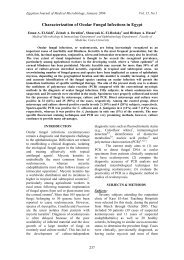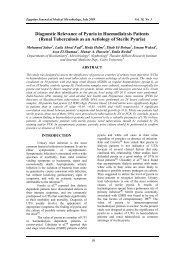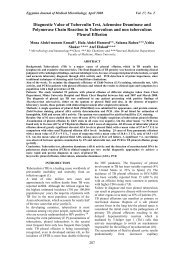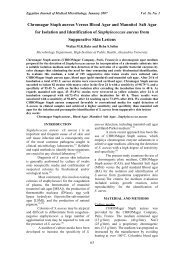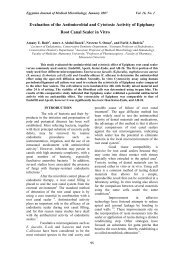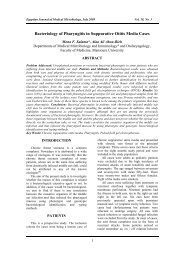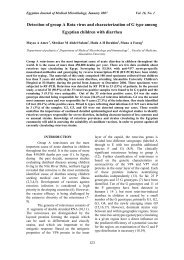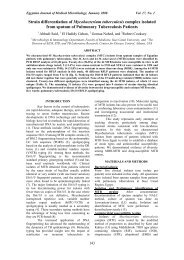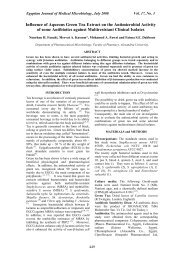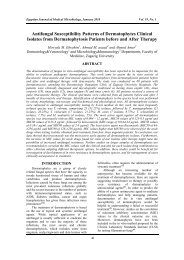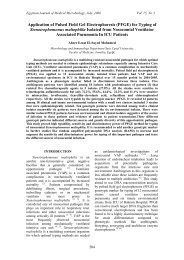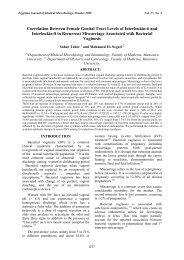Egyptian Journal <strong>of</strong> Medical Microbiology, January 2010 Vol. 19, No. 1<strong>H1N1</strong> is susceptible to neuramidinase inhibitorsbut not to M2 inhibitors 6Swine influenza virus (SIV) can betransmitted through droplet <strong>and</strong> infected fomitis.The symptoms range from fever <strong>and</strong> anorexia tocoughing, rhinorhea, <strong>and</strong> gastrointestinal upset.Pneumonia, respiratory failure, <strong>and</strong> deaths havebeen reported <strong>with</strong> swine flu infection inhumans; <strong>and</strong>, as <strong>with</strong> seasonal influenzaoutbreaks, SIV in humans can worsenunderlying chronic conditions 6 .Warning signs should be watched inpatients <strong>with</strong> confirmed <strong>H1N1</strong> or suspected tobe infected that predict progression to moresevere disease which include shortness ordifficulty <strong>of</strong> breath, turning blue, bloody orcolored sputum, chest pain, altered mentalstatus, high fever that persists after 3 days, lowblood pressure, recurrence <strong>of</strong> fever afterimprovement which may indicate secondarypneumonia. In children, danger signs includefast or difficult breathing, lack <strong>of</strong> alertness,difficulty in waking up <strong>and</strong> little or no desire toplay 7 .The aim <strong>of</strong> this work was to describebaseline characteristics, treatment, <strong>and</strong>prognosis in patients <strong>with</strong> influenza A (<strong>H1N1</strong>)admitted to a Saudi hospital <strong>and</strong> compare ourfindings <strong>with</strong> similar data published elsewhere.SUBJECTS & METHODSThis study was conducted over 4 months inthe period from September 2009 to January2010, from patients in Chest Department, PrinceAbd El Mohsen General Hospital , MadinahMonawarha .Ninety seven patients wereincluded in the study; (52) males <strong>and</strong> (45)females. Inclusion criteria consisted <strong>of</strong>: febrile(> 38°C) acute illness; respiratory symptomsconsistent <strong>with</strong> cough, sore throat, myalgia orinfluenza-like illness; acute respiratory failurerequiring intensive care unit (ICU) admission;plus microbiologic confirmation <strong>of</strong> novelinfluenza A (<strong>H1N1</strong>). <strong>Patients</strong> were admitted inisolation ward .- According to the regulation <strong>of</strong> Ministry <strong>of</strong>Health, Kingdom <strong>of</strong> Saudi Arabia; Anypatient suffered from flu symptoms morethan 3 days ; nasopharyngeal aspirates wereobtained , tested by RT-PCR for <strong>H1N1</strong> <strong>and</strong>started ostelemivir treatment <strong>and</strong> alsocontacts . The continuity <strong>of</strong> treatment or notwas according to PCR results.- From all patients <strong>with</strong> flu symptoms; only'confirmed cases' were included in thecurrent study.84- Primary viral pneumonia was defined inpatients presenting during the acute phase <strong>of</strong>influenza virus illness <strong>with</strong> acute respiratorydistress <strong>and</strong> unequivocal alveolaropacification involving two or more lobes<strong>with</strong> negative respiratory <strong>and</strong> blood bacterialcultures.- The ICU admission criteria <strong>and</strong> treatmentdecisions for all patients were made by theattending physician.- All patients were subjected for:- Medical history taking <strong>and</strong> clinicalexamination including :1. Demographic data,2. Comorbidities,- Time <strong>of</strong> illness onset <strong>and</strong> hospital admission,- Time to first dose <strong>of</strong> antiviral treatment.- Nasopharyngeal swab specimens werecollected at admission <strong>and</strong> respiratorysecretions were also obtained in intubatedpatients <strong>and</strong> put on viral transport media .These specimens were sent to King FahdReferral Hospital for RT-PCR .- Specimens were cultured on Blood,MacConkey's, <strong>and</strong> Chocolate agars toexclude concomitant bacterial disease.- Blood samples were obtained <strong>and</strong> subjectedto blood cultures on Bactec 9240 automatedblood culture system to exclude other causes<strong>of</strong> fever.- Chest radiologic findings at ICU admission.- Intubation <strong>and</strong> mechanical ventilationrequirements.- Laboratory finding at ICU admission werealso recorded to determine the severity <strong>of</strong>illness.- All patients were confirmed by RT-PCR forp<strong>and</strong>emic <strong>H1N1</strong> virus using kits from RocheDiagnostics (Germany) which included:- RNA extraction: 200 ul <strong>of</strong> binding bufferwas added to 200 ul <strong>of</strong> samplesupplemented <strong>with</strong> 4 ul poly A <strong>and</strong> 50 ul<strong>of</strong> proteinase K , mixed thoroughly <strong>and</strong>incubated for 10 min at 72 o C then mixed<strong>with</strong> 100 ul binding buffer, transferred tocombined filter <strong>and</strong> collection tubes ,centrifuged for 35 sec at 8000xg,flowthrough was discarded. 500 ul <strong>of</strong>inhibitor removal buffer was added <strong>and</strong>centrifuged again for 1 min at 8000xg<strong>with</strong> discard <strong>of</strong> the flowthrough. 450 ul <strong>of</strong>wash buffer was added <strong>and</strong> centrifugedagain 1 min at 8000xg, washed <strong>and</strong>centrifuged again, followed by centrifuge10 sec at 13000xg <strong>with</strong> discard <strong>of</strong>flowthrough. To elute viral RNA 50 ul <strong>of</strong>elution buffer was added <strong>and</strong> centrifuged
Egyptian Journal <strong>of</strong> Medical Microbiology, January 2010 Vol. 19, No. 18000xg for 1 min, then RT-PCR wasperformed on viral RNA.- RT: Using transcriptor first str<strong>and</strong> cDNAsynthesis kit , RNA is reverse transcribedinto single str<strong>and</strong>ed cDNA which can beused directly for subsequent RCR <strong>with</strong>gene specific primers on conventionalthermal block cycler <strong>and</strong> real time PCRinstrument . Master mix was prepared byadding 2ul <strong>of</strong> r<strong>and</strong>om hexamer primer,11ul <strong>of</strong> RNA template then mixture (13ul)incubated at 65 o C for 10 min then placedimmediately in ice. A mixture (7ul) <strong>of</strong> 4ul<strong>of</strong> transcriptor reverse trascriptasereaction buffer, 0.5ul <strong>of</strong> protector RNAseinhibitor, 2ul <strong>of</strong> deoxynucleotide mix,0.5ul <strong>of</strong> transcriptor reverse trascriptasewas prepared <strong>and</strong> mixed <strong>with</strong> previousmixture <strong>of</strong> 13ul to make total volume <strong>of</strong>20 ul . The reaction was centrifuged tocollect liquid in bottom, then incubated10 min at 25 o C followed by 30 min at55 o C. Transcriptor reverse trascriptasewas inactivated by heating at 85 o C for 5min. The reaction was stopped by placingin ice.- The recommended procedure for testingfor the new <strong>Influenza</strong> A/<strong>H1N1</strong> virus is thedetection <strong>of</strong> the M2 gene for <strong>Influenza</strong> A.Positive samples are then tested targetingthe specific H1 gene or parallel testing <strong>of</strong>both targets is performed. Theprimer/probe set for detection <strong>of</strong> <strong>Influenza</strong>A Hemagglutinin HA1 has beenrecommended by the Robert KochInstitute in Berlin, Germany 8. Table (1)shows primers <strong>and</strong> probes used in PCR.Table 1: Primers <strong>and</strong> probes for detection <strong>of</strong> p<strong>and</strong>emic <strong>H1N1</strong> 2009 virusAssay <strong>and</strong> Primer/probe Nucleotide Primer/probe sequence (5 –3 )gene target namelocationHAHAHAHA-359_ForHA-405_RevHA-386_Probe359–381405–424386–403AGCAATTGAGCTCAGTGTCATCATGGGCCATGAACTTGTCTTGFAM-AAAGGTTTGAGATATTCC-BHQ1bM2M2M2M-408-ForM-455_RevM-434_Probe408–432455–485434–450ACAGAAGCTGCTTTTGGTCTAGTGTTGAGACCGATGCTGTGAATCAFAM-TGCCACTTGTGAACAGA-BHQ1- RT-PCR: Master mix was prepared for20 ul capillary tube by adding ; 8.6ulPCR grade water, 2.4ul <strong>of</strong> MgCl2 , 2ul<strong>of</strong> fast start master mix <strong>and</strong> 2ulprimer/probe mix. 5ul <strong>of</strong> viral RNAsample, positive or negative controlwere dispensed in separate tube <strong>with</strong> thesame reaction mixture. Mixture weretransferred to the respective <strong>of</strong> LightCycler ®Capillaries, which werespinned in a microcentrifuge at 700×g(3,000rpm) for 10 sec , <strong>and</strong> placed intothe Light Cycler ® 2.0 system to startthe PCR program.RESULTSThe current study was conducted on 97patients whom were admitted to hospital due to<strong>H1N1</strong> infection .Their age ranged between 12<strong>and</strong> 75 (mean 34± SD 16.99). Seventy twopatients (74.2%) ranged between 14 <strong>and</strong> 40years old (mean 25.29 ± 7.98), <strong>and</strong> 16 patients(16.5%) were less than 52 years old (mean 45 ±4.08). Nine patients (9.3%) were older than 65years old (mean 69 ±3.4). Fifty two patients(53.6%) were males, forty five patients (46.4%)were females, 4 <strong>of</strong> them were pregnant.All patients included were admitted tohospitals due to flu symptoms more than 3 days,flu symptoms <strong>with</strong> underlying chronic diseaseor presenting pneumonia. Figure (1) showspercentage <strong>of</strong> different symptoms in studiedgroup.The most common comorbidities weresmoking (18 patients), lung diseases; mainlybronchial asthma (BA) (11 patients) <strong>and</strong>exacerbated chronic obstructive lung disease(COPD) (7 patients). Only one patient hadsevere obesity (body mass index > 40). Table(2) shows the comorbidities in the studiedgroup.The average duration <strong>of</strong> hospital stay wasbetween 5 <strong>and</strong> 7 days.All patients received initial empiricantibiotic therapy. Most frequent regimens werebeta lactam plus macrolides, In addition twoICU admitted patients received intravenoussteroids.All patients were administered oseltamivir,3 <strong>of</strong> them were administered higher doseoseltamivir up to 150 mg oral twice a day.85



